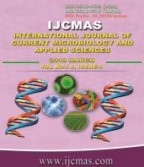


 National Academy of Agricultural Sciences (NAAS)
National Academy of Agricultural Sciences (NAAS)

|
PRINT ISSN : 2319-7692
Online ISSN : 2319-7706 Issues : 12 per year Publisher : Excellent Publishers Email : editorijcmas@gmail.com / submit@ijcmas.com Editor-in-chief: Dr.M.Prakash Index Copernicus ICV 2018: 95.39 NAAS RATING 2020: 5.38 |
Seafood is the most significant perishable commodity. Decomposition of seafood, especially during storage at elevated temperatures (48ËšC), various amounts of selected biogenic amines is usually produced, depending on the fish species. Most common biogenic amines in seafood associated with spoilage are histamine, tyramine, putrescine and cadaverine which are formed by bacteria that decarboxylases the corresponding free amino acids. Histamine is known as a biogenic amine which is low molecular weight and possesses biological activity. Histamine poisoning also referred to as ‘Scombroid fish poisoning’. The levels of histamine have been suggested as rapid fish spoilage indicators. The reason for the monitoring of selected biogenic amines in seafood is twofold: as indices of decomposition and to prevent potential toxicity on human health. Different determination methods have been reported for the analysis of histamine, including Thin-layer chromatography. Gas chromatography, Colorimetric assay, Fluorometric assay, Enzymatic assay, Immunological assay, High-performance liquid chromatography. Simple and rapid method for monitoring histamine levels in fish and fishery products are Biosensors, Eliza, colorimetric methods.
 |
 |
 |
 |
 |